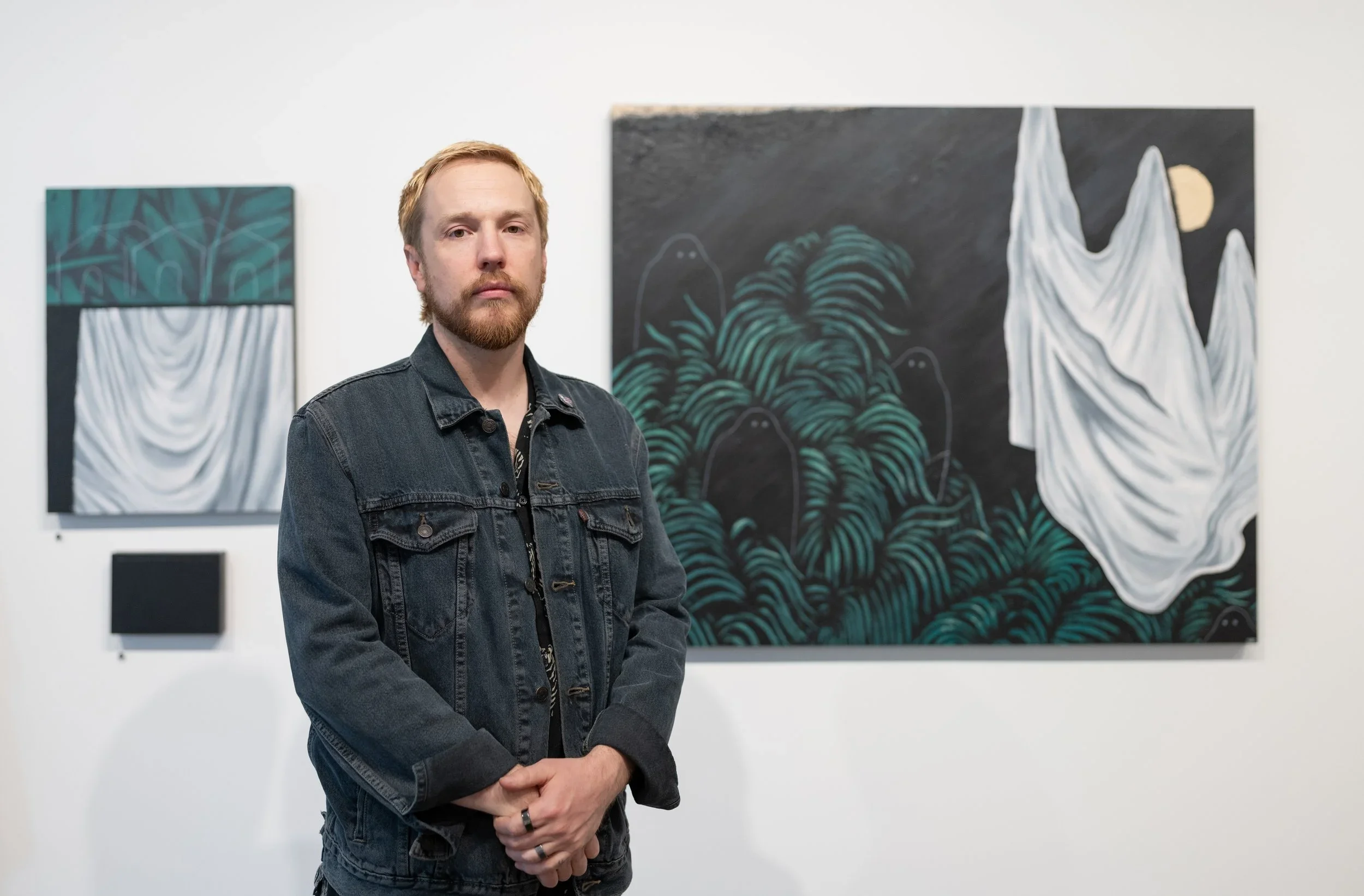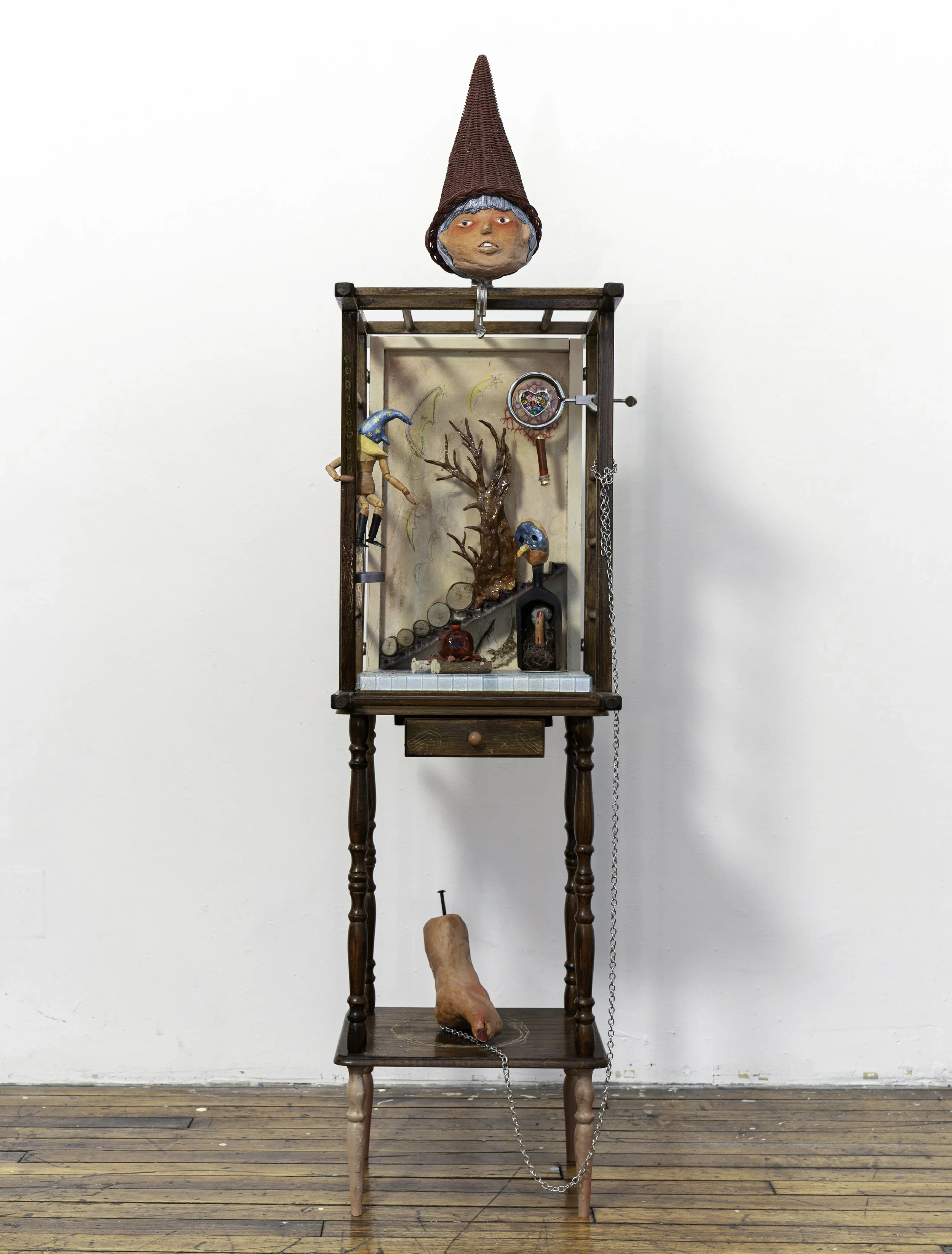10 Questions with Marcus Brown
Al-Tiba9 Art Magazine ISSUE18 | Featured Artist
A native of Bulbancha, New Orleans, Marcus Brown is a sculptor, painter, inventor, musician, and educator. Brown holds an M.Ed. from Portland State University and a BFA from Kansas City Institute of Art (KCAI) in Missouri. His work is expansive and includes national and international exhibits and performances in New York City, Berlin, Germany, Krakow, Poland, Venice, Italy and Seoul, South Korea. Brown developed a form of painting called Electro-sonic Painting in which the artist paints with sound/data-producing instruments. He has performed with his invention internationally. In addition to his performance art, Brown has exhibited with artists such as Andy Warhol, Chris Burden, Hannah Wilke, and others around the world. Brown is currently combining a new form of creative storytelling using Augmented Reality (AR) sculptures with interactive multimedia elements. His latest national project, Slavery Trails, is a musically interactive site-specific augmented reality (AR) installation series based on slave ships and enslaved people, placed on historical sites throughout the United States. The series is Brown’s effort to create a decentralized memorial to slavery in the United States.
Marcus Brown - Portrait
ARTIST STATEMENT
Marcus Brown’s mission is to create artworks that educate the public about important issues while transcending both media and societal boundaries. As an artist with enslaved African ancestors, he feels a profound responsibility to use his work to tell their stories and to create new pieces that empower and unite diverse communities. Brown views his role as an artist as simultaneously technical, scholarly, and performative. In his creative process, he draws upon African American and Creole traditions, employing a wide variety of media languages. Much like a New Orleans chef who skillfully combines diverse ingredients to create a rich gumbo, Brown integrates visual, auditory, performative, and interactive media into compositions designed to re-conceptualize and re-spiritualize contemporary culture. His artistic approach is deeply influenced by the musical traditions of his African American, Native American, and European heritage.
Ma Brown, Acrylic on Acrylic, 24 x 36 in, 2022 © Marcus Brown
AL-TIBA9 ART MAGAZINE ISSUE18
INTERVIEW
Please tell our readers how you developed into the artist you are today. What training or experiences helped you along the way?
My journey as an artist began very early. As a young child, I remember drawing on brown paper bags at my grandmother's house and in nursery school. Although I didn't have formal art classes in elementary school, I was deeply inspired by my grandmother, "Meme," who herself was a painter. Her paintings sparked my early interest in art and motivated me to keep drawing. My first structured art education didn't happen until seventh grade. However, a pivotal moment came when I was accepted into the New Orleans Center for Creative Arts during high school. NOCCA truly changed my life, giving me essential training and the confidence to pursue a Bachelor of Fine Arts degree at the Kansas City Art Institute.
After earning my degree, I married my best friend, fellow artist Laura Sirkin-Brown. Three months after returning to my hometown of New Orleans, we were impacted profoundly by Hurricane Katrina. Forced to evacuate with friends and family, I found myself experimenting creatively in hotel rooms, using electronic devices and amplifiers I'd begun developing back home. It was during this turbulent period that I first conceived my Electro-Sonic paintings and sound paintings—using whatever tools were available to express myself artistically in new ways.
Machine Noire, Acrylic on Acrylic (performance still), 24 x 36 in, 2022 © Marcus Brown
Your work spans multiple disciplines, such as sculpture, painting, music, and performance art. How do these mediums interact in your creative process, and what drives you to work across so many forms of expression?
I feel a deep internal drive to create art using whatever medium I can master, which naturally leads me toward multimedia expression. Growing up in New Orleans, where music and art are intertwined with daily life, has profoundly shaped this multidisciplinary approach. My creative process is highly experimental—almost scientific—relying heavily on research and development. Creating interactive controllers that allow me to blend sculpting, painting, and music—such as playing my saxophone through a paintbrush or sculpting knife—has been essential to my artistic evolution. Over the years, acquiring diverse skills has become central to my creative practice, allowing me to express ideas in complex, layered ways.
You often incorporate elements of African American and Creole traditions into your work. How do these cultural influences shape the stories you tell through your art?
African American and Creole traditions strongly inform the colours, rhythms, and energy in my art, particularly in my Electro-Sonic paintings. The musical traditions of New Orleans—second lines, jazz, funk, and improvisational jams—play a vital role in shaping my artistic identity. Often, my collaborations with other musicians involve improvisation using both traditional and unconventional instruments, echoing the dynamic, communal spirit of my cultural heritage. The vibrant aesthetics of New Orleans, particularly the intricate ironwork craftsmanship, and Haitian, French, and Spanish architectural influences found in the Treme neighbourhood also significantly influence my visual language.
Sucker Red, Acrylic on Acrylic, 24 x 36 in, 2022 © Marcus Brown
KCAI 2023, Acrylic on Acrylic, 24 x 36 in, 2023 © Marcus Brown
Electro-Sonic Painting is such a unique fusion of sound and visual art. What inspired you to develop this technique, and how has it evolved over time?
Electro-Sonic Painting emerged directly from my fascination with the musical traditions of New Orleans, especially jazz improvisation. I envisioned creating a conversation between sound and materials, inspired by how musicians converse through instruments. My early sound paintings were percussive: I recorded myself creating rhythms on sound-producing canvases wired with handmade microphones and looped these sounds as I painted. Initially, my tools were analogue, consisting of microphones and synthesizers. The disruption of Hurricane Katrina in 2005 deeply impacted my development of Electro-Sonic Painting. Evacuating to Portland, Oregon, I found myself improvising with whatever tools I had, leading to innovations and new artistic possibilities.
Music plays an integral role in your performances. How do you approach the relationship between sound, space, and audience in your interactive works?
The type of interaction I seek to create guides my approach. I view interactive art as an opportunity for magical experiences—something transformative and immersive. When audiences feel they can play with and influence the art, it becomes a profound form of storytelling. I aim to draw viewers into the experience, giving them a sense of wonder and discovery. Through careful consideration of how sound and space interact, I strive to create immersive environments that captivate and emotionally engage the audience.
Your artist statement speaks of "re-conceptualizing and re-spiritualizing contemporary culture." How do you see your work reshaping historical narratives and cultural memory?
My work seeks to challenge how history is traditionally presented. American history has often been shaped by those in power, emphasizing narratives and erasing others. I believe art possesses a mysticism and purpose beyond mere decoration—something largely forgotten in Western culture. Like African mask-makers creating ceremonial masks, Native American dancers preparing elaborate suits for powwows, or the Black masking Indians of New Orleans crafting suits for annual rituals, my art aims to reconnect contemporary audiences to deep cultural memories and spiritual meanings. Through this approach, I hope to reshape and reframe how we engage with history and culture.
Machine Noire, Acrylic on Acrylic, 24 x 36 in, 2022 © Marcus Brown
Machine Noire, Acrylic on Acrylic, 24 x 36 in, 2022 © Marcus Brown
Your latest project, Slavery Trails, uses Augmented Reality to create site-specific memorials. Can you share the concept behind this project and how you envision the public interacting with them?
Slavery Trails is my effort to create a decentralized memorial to slavery across the United States. This series of site-specific, musically interactive augmented reality installations honours enslaved individuals and commemorates the historical locations of slavery. These AR installations vividly represent the histories associated with these spaces, challenging viewers to actively engage through their digital devices. The interactive nature of the installations invites deep, personal reflection, aiming to fill gaps in public education and historical understanding.
Technology is a recurring element in your work, from Electro-Sonic Painting to Augmented Reality. What excites you about using new media in art, and are there any emerging technologies you're interested in exploring next?
Technology excites me because it allows art to become something unexpected and immersive, drawing viewers into new experiences. Using technology in my art amplifies ideas and enables me to engage diverse audiences more directly. I'm particularly interested in exploring sustainable and environmentally conscious technologies that minimize pollution and energy use. Projects like Slavery Trails leverage personal devices that everyone already carries, maximizing the impact of the art while reducing its ecological footprint.
As an educator, how do you engage with younger generations of artists, and what lessons do you hope to pass on to them?
Teaching young artists is immensely important to me. Art education encourages inventive thinking and creative problem-solving. At the New Orleans Center for Creative Arts (NOCCA), I work with passionate young artists committed to their growth and creativity. I strive to instil the value of passing knowledge to future generations, emphasizing that the creative skills learned through art can empower them in every aspect of their lives.
Taken Homeland, Acrylic on Acrylic, 24 x 36 in, 2022 © Marcus Brown
And lastly, what upcoming projects or ideas are you currently working on, and how do you see your artistic practice evolving in the future?
Currently, I'm developing a series of new exhibits in New York City as part of the Slavery Trails project, with new installations in Manhattan and Brooklyn. These exhibitions travel annually, bringing attention to New York's overlooked history of slavery. Currently, I have four exhibits in New York City Slave Market: Wall Street at Wall Street and Water Street, Slave Market Wall Street at The Slave Market: Wall Street at Capsuoto Park, American Gold I at North 5th Park and Pier in Brooklyn and American Gold II at Queensbridge Park in Queens. I'm also working on a Slavery Trails book and producing an Electro-Sonic Painting album. Looking ahead, I see my practice continually evolving to incorporate new technologies, engaging broader audiences, and deepening my exploration of historical narratives through interactive, immersive art experiences.
Artist’s Talk
Al-Tiba9 Interviews is a promotional platform for artists to articulate their vision and engage them with our diverse readership through a published art dialogue. The artists are interviewed by Mohamed Benhadj, the founder & curator of Al-Tiba9, to highlight their artistic careers and introduce them to the international contemporary art scene across our vast network of museums, galleries, art professionals, art dealers, collectors, and art lovers across the globe.


























